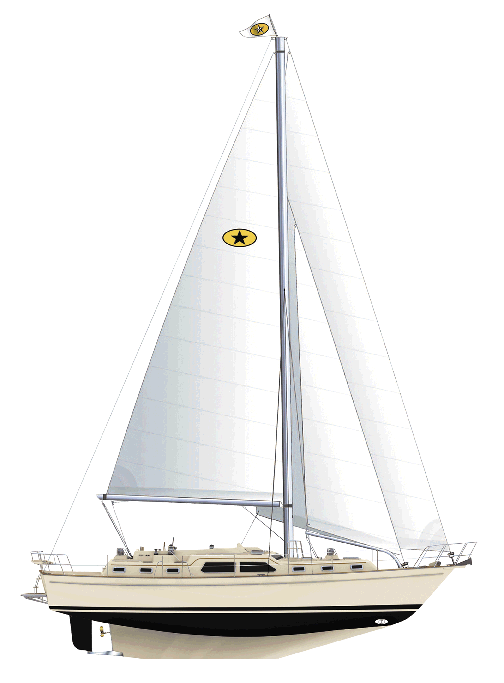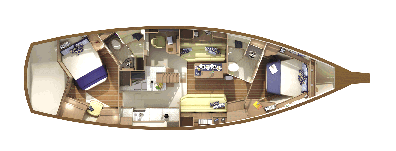Island Packet 465
2007 December 5
December 2007
Bluewater cruiser
Island Packet introduced the center-cockpit IP 485 about five years ago and it was a hit. The 485 led to a smaller version, the 445. Island Packet felt some "evolutionary changes" would benefit the 445 and the design has been reintroduced as the new 465. Design credit is given to IP President Bob Johnson.
I'm going to guess here that the IP 465 uses the same parent hull as the 445 but the stern has been changed, with a traditional raked transom replacing the 445's reverse transom. The immediate effect of this change is to draw out the lines of the boat by adding length to the sheer and adding volume aft for the lazarette. Given the overall traditional styling of the IP I feel this transom fits the look better and adds length on deck and that's always handy. The problem with the traditional transom is that it does not allow a swim platform to be cut into it. Face it, we all like swim platforms and the ease they provide in getting in and out of the dinghy. But there is a solution here that is often overlooked. You can do a traditional transom and add a swim step powerboat style, hanging the platform off the transom and supporting it with metal brackets. It does not sound elegant but the fact is that it works very well and aesthetically has very minimal impact on the overall look of the boat. I like this detail and I have used it myself.
I'd call this design a "full-keel" type as opposed to a "modified" full keel. If you look at the intersection of the bow and the leading edge of the keel you will see very little distinction of where the forefoot ends and the keel begins. With a modified full keel we would see far more distinct forefoot and canoe body before running into the leading edge of the keel. The high sweep angle of the leading edge is quite effective when coupled with this low-aspect-ratio keel, and with a minimal draft of 5 feet you will need all the effectiveness you can get with this keel. The ballast is fully encapsulated in this large keel. For a fin-keeled boat the D/L of this design is on the high side at 278, but that's on the low side for a full keel design. The L/B is 3.4, almost textbook medium. Note that the rudder arrangement, with some balance, allows the performance advantages of the spade rudder while providing a lower bearing for support.
 The accommodation plan is designed for two couples. There is a stateroom forward with an island double berth. There is direct access to the forward head from this stateroom and the head has a large shower stall. The forward head is accessible also from the saloon without entering the forward stateroom. The aft head shows a small wet locker. It's not the most convenient of places for a wet locker as you have to go through the aft stateroom to get to it, but at least there is one. The nav station is quite generous in its proportions and features a swivel chair. The galley is situated in the passageway to the aft cabin. It's a well-designed galley with a lot of counter space. Headroom in the saloon is 7 feet. The deep settees look very comfortable and there is a drop-down table that hinges off the forward bulkhead. The port settee converts to another double berth. The angled double berth aft looks weird to my eye but I can't see why it would not work fine when at anchor. Note the large lazarette.
The accommodation plan is designed for two couples. There is a stateroom forward with an island double berth. There is direct access to the forward head from this stateroom and the head has a large shower stall. The forward head is accessible also from the saloon without entering the forward stateroom. The aft head shows a small wet locker. It's not the most convenient of places for a wet locker as you have to go through the aft stateroom to get to it, but at least there is one. The nav station is quite generous in its proportions and features a swivel chair. The galley is situated in the passageway to the aft cabin. It's a well-designed galley with a lot of counter space. Headroom in the saloon is 7 feet. The deep settees look very comfortable and there is a drop-down table that hinges off the forward bulkhead. The port settee converts to another double berth. The angled double berth aft looks weird to my eye but I can't see why it would not work fine when at anchor. Note the large lazarette.
 The SA/D for this rig is 16.94 if I use IP's listed sail area. There is a Hoyt boom for the staysail. The clews of the headsails are high and the mainsail boom is also high. I suspect the boom height is to provide room for a bimini and that also would account for the angle on the mainsheet. A 75-horsepower Yanmar will push the 465 along nicely in light air. Island Packet continues to produce excellent cruising boats in a traditional, full-keel design.
The SA/D for this rig is 16.94 if I use IP's listed sail area. There is a Hoyt boom for the staysail. The clews of the headsails are high and the mainsail boom is also high. I suspect the boom height is to provide room for a bimini and that also would account for the angle on the mainsheet. A 75-horsepower Yanmar will push the 465 along nicely in light air. Island Packet continues to produce excellent cruising boats in a traditional, full-keel design.
Bluewater cruiser

Island Packet introduced the center-cockpit IP 485 about five years ago and it was a hit. The 485 led to a smaller version, the 445. Island Packet felt some "evolutionary changes" would benefit the 445 and the design has been reintroduced as the new 465. Design credit is given to IP President Bob Johnson.
I'm going to guess here that the IP 465 uses the same parent hull as the 445 but the stern has been changed, with a traditional raked transom replacing the 445's reverse transom. The immediate effect of this change is to draw out the lines of the boat by adding length to the sheer and adding volume aft for the lazarette. Given the overall traditional styling of the IP I feel this transom fits the look better and adds length on deck and that's always handy. The problem with the traditional transom is that it does not allow a swim platform to be cut into it. Face it, we all like swim platforms and the ease they provide in getting in and out of the dinghy. But there is a solution here that is often overlooked. You can do a traditional transom and add a swim step powerboat style, hanging the platform off the transom and supporting it with metal brackets. It does not sound elegant but the fact is that it works very well and aesthetically has very minimal impact on the overall look of the boat. I like this detail and I have used it myself.
I'd call this design a "full-keel" type as opposed to a "modified" full keel. If you look at the intersection of the bow and the leading edge of the keel you will see very little distinction of where the forefoot ends and the keel begins. With a modified full keel we would see far more distinct forefoot and canoe body before running into the leading edge of the keel. The high sweep angle of the leading edge is quite effective when coupled with this low-aspect-ratio keel, and with a minimal draft of 5 feet you will need all the effectiveness you can get with this keel. The ballast is fully encapsulated in this large keel. For a fin-keeled boat the D/L of this design is on the high side at 278, but that's on the low side for a full keel design. The L/B is 3.4, almost textbook medium. Note that the rudder arrangement, with some balance, allows the performance advantages of the spade rudder while providing a lower bearing for support.
 The accommodation plan is designed for two couples. There is a stateroom forward with an island double berth. There is direct access to the forward head from this stateroom and the head has a large shower stall. The forward head is accessible also from the saloon without entering the forward stateroom. The aft head shows a small wet locker. It's not the most convenient of places for a wet locker as you have to go through the aft stateroom to get to it, but at least there is one. The nav station is quite generous in its proportions and features a swivel chair. The galley is situated in the passageway to the aft cabin. It's a well-designed galley with a lot of counter space. Headroom in the saloon is 7 feet. The deep settees look very comfortable and there is a drop-down table that hinges off the forward bulkhead. The port settee converts to another double berth. The angled double berth aft looks weird to my eye but I can't see why it would not work fine when at anchor. Note the large lazarette.
The accommodation plan is designed for two couples. There is a stateroom forward with an island double berth. There is direct access to the forward head from this stateroom and the head has a large shower stall. The forward head is accessible also from the saloon without entering the forward stateroom. The aft head shows a small wet locker. It's not the most convenient of places for a wet locker as you have to go through the aft stateroom to get to it, but at least there is one. The nav station is quite generous in its proportions and features a swivel chair. The galley is situated in the passageway to the aft cabin. It's a well-designed galley with a lot of counter space. Headroom in the saloon is 7 feet. The deep settees look very comfortable and there is a drop-down table that hinges off the forward bulkhead. The port settee converts to another double berth. The angled double berth aft looks weird to my eye but I can't see why it would not work fine when at anchor. Note the large lazarette. The SA/D for this rig is 16.94 if I use IP's listed sail area. There is a Hoyt boom for the staysail. The clews of the headsails are high and the mainsail boom is also high. I suspect the boom height is to provide room for a bimini and that also would account for the angle on the mainsheet. A 75-horsepower Yanmar will push the 465 along nicely in light air. Island Packet continues to produce excellent cruising boats in a traditional, full-keel design.
The SA/D for this rig is 16.94 if I use IP's listed sail area. There is a Hoyt boom for the staysail. The clews of the headsails are high and the mainsail boom is also high. I suspect the boom height is to provide room for a bimini and that also would account for the angle on the mainsheet. A 75-horsepower Yanmar will push the 465 along nicely in light air. Island Packet continues to produce excellent cruising boats in a traditional, full-keel design.
Comments